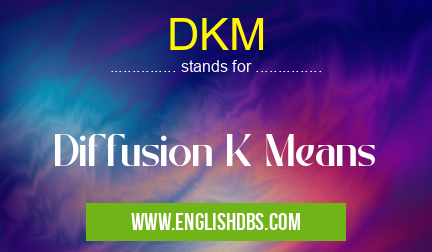What does DKM mean in UNCLASSIFIED
DKM stands for Diffusion K Means. It is an advanced clustering algorithm used in data mining and machine learning to identify patterns and structures within large datasets.

DKM meaning in Unclassified in Miscellaneous
DKM mostly used in an acronym Unclassified in Category Miscellaneous that means Diffusion K Means
Shorthand: DKM,
Full Form: Diffusion K Means
For more information of "Diffusion K Means", see the section below.
What is DKM?
DKM is a hybrid algorithm that combines elements of k-means clustering with diffusion maps. It aims to overcome limitations of traditional k-means clustering, such as sensitivity to initial cluster assignments and difficulty in handling non-convex data.
How does DKM work?
DKM operates in two main steps:
-
Diffusion Map Construction: The data is transformed into a diffusion map, which preserves the local neighborhood relationships between data points.
-
K-Means Clustering: K-means clustering is applied to the diffusion map to identify clusters. This step utilizes the information captured in the diffusion map to improve cluster assignments.
Advantages of DKM
- Improved cluster quality compared to traditional k-means
- Robust to noise and outliers
- Can handle non-convex and complex data
- Efficient for large datasets
Disadvantages of DKM
- More computationally expensive than traditional k-means
- May require parameter tuning for optimal results
- Can be sensitive to the choice of diffusion map parameters
Applications of DKM
DKM has been successfully applied in various domains, including:
- Image segmentation
- Document clustering
- Biomedical data analysis
- Financial data mining
Essential Questions and Answers on Diffusion K Means in "MISCELLANEOUS»UNFILED"
What is Diffusion K Means (DKM)?
Diffusion K Means (DKM) is a variant of the popular K Means clustering algorithm designed for large datasets. It combines the efficiency of K Means with the robustness of diffusion maps, a dimensionality reduction technique.
How does DKM work?
DKM starts by constructing a diffusion map of the data. The diffusion map captures the local connectivity of the data points and can reveal hidden patterns and structures. K Means is then applied to the diffusion map, using the distances between data points on the map to assign them to clusters.
What are the advantages of using DKM?
DKM offers several advantages over traditional K Means, including:
- Scalability: DKM can efficiently handle large datasets due to the use of diffusion maps.
- Robustness: DKM is less sensitive to noise and outliers compared to K Means.
- Enhanced cluster quality: DKM often produces more cohesive and well-separated clusters due to the pre-processing step using diffusion maps.
What are the limitations of DKM?
DKM has some limitations, such as:
- Computational cost: Constructing the diffusion map can be computationally intensive for large datasets.
- Parameter selection: DKM requires the selection of parameters for both the diffusion map and K Means, which can affect the clustering results.
When should I use DKM?
DKM is a suitable choice for clustering large-scale datasets, especially when the data exhibits complex structures or noise. It is particularly effective in applications such as image segmentation, text mining, and social network analysis.
Final Words: DKM is a valuable tool for data mining and machine learning tasks. It provides improved clustering performance over traditional k-means, making it suitable for complex and large datasets. However, users should be aware of its computational requirements and potential sensitivity to parameter choices.
